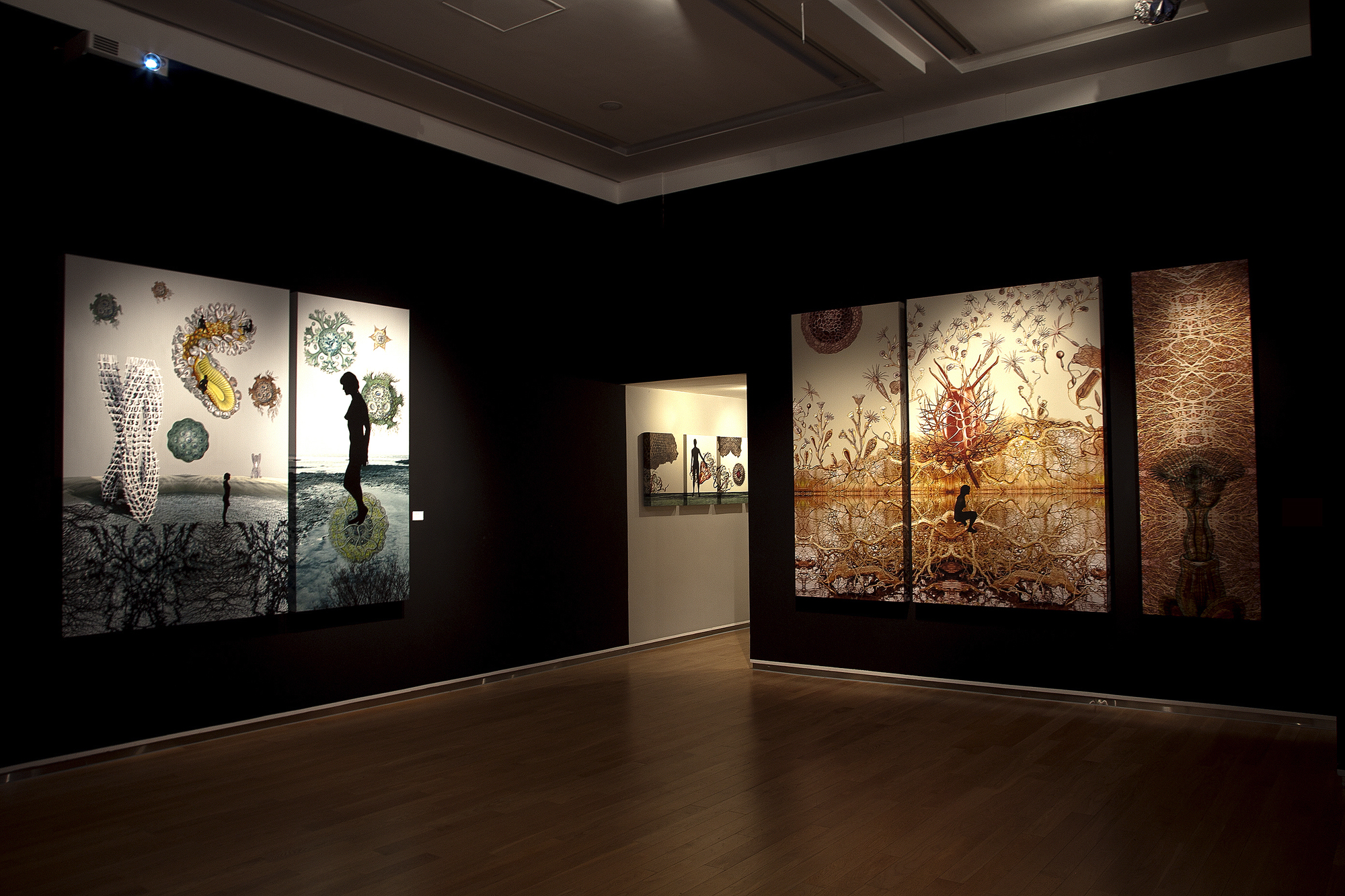

|
TRANSITORY SHORES & BIOMORPHIC DAYDREAMS II DIPTYCH ACRYLIC, SERIGRAPHY, INKS AND OILS ON CANVAS FROM THE SERIES EMBRYONIC PLANTS & OTHERWORLDS 2013 |
|
 |
|
|
The labyrinth or networks of veins in 'Embryonic plant: Hyper bloom', map a chaos of unknown but compulsive order which circulated through every living being in nature's mechanics. The visuals at once suggest the vulnerability of decay inherent in the formation of the new. The embryonic springs to life the chaste development of a new seed, a renewal that will explode into a hyper-bloom. The throbbing pulse of the vital, fragile form is treated cautiously to prevent deformation and create the right kind of growth and transcendence into evolution. Describing the prime centre of this series, Sonia speaks about the images that constantly reoccur to reveal composite systems and structures, both within and outside the body - mapping the 'inside-out' - thereby creating a sublime but decadent imagery. The artist says that her "work often concerns the internal mechanisms of visual imagery and the process in which these mechanisms address the mind. Networks of intricately interwoven branches are exaggerated to resemble blood vessels and arteries within the body." Images of beauty and exuberance are infused with a sense of the macabre and both time and space are impregnated with a sense of heightened reality. 'Distant Shores and Biomorphic Daydreams' discover the evolution of shapes with the dominating presence of the assertive but genteel femme, while blurring boundaries between life forms of humans, animals, plants and organisms. The experience of these imagined spaces centred on the female form and nature, are the centre of ephemeral love, life cycles, decay and regeneration. The artist refers to this feminine aspect as one that relentlessly questions the conventional notions of beauty and desire. Her subjects transforms from taut youth to withering wrinkles, only to regenerate through her offspring's maternal roots. Akin to a constellation peppered across this series, the artist's recurring forms create an invisible web around the works and the viewers entering this space. An exchange of sap causes a realisation of change in the mundane and renewed outlook into the future of the past world within worlds of realised utopias. The artist, who is strongly influenced by the thoughts of Michel Foucault, reflects on his philosophy of "heterotopias" that designate real or imagined spaces of escape, departure, transformation and revelation. She creates an arrangement of realised utopias within the concept of heterotopias, which could suggest a mirror of our own experience, thereby letting the viewer connect with the artist's work at a subjective level. There is a clearing in the visual distance that is so new; it cannot be grasped at once. Sonia's works are an ecology related evolution, correlated to the natural world, evolution and the human form, translating and transitioning nature's complicated system and growing pains into blooms of futuristic, real fantasies of utopias. The viewer seeps into this labyrinth to become a part of a new developing aesthetic. Excerpts from Biomorphics of Evolution by Veeranganakumari Solanki http://www.aestheticamagazine.com/yinchuan-biennale-2016/ | |
| In Sonia Mehra Chawla's works, the artist persona often appears as an archetypal figure mediating between the enigmas of the natural world and the experimental protocols that science devises to investigate them. Her mixed-media paintings, prints and video works assume the form of encounters between mystery and inquiry. In her 2009-2011 series, 'Some Roots Grow Upwards: The Transformative Experience of the Biological Imperative: Both Desired and Despised', for instance, the artist persona takes a nap on a couch while a dream play involving the human body, stripped to nerve, muscle and bone, unfolds around her; neural electricity links her to a ghostly X-ray double, heavy with child, and to pensive skeletons drawn from the history of anatomical representation. Her own bodily experiences, especially of pregnancy and childbirth, provide a recurrent basis for Sonia's reflections. Incrementally, during the last decade, she has developed a vocabulary of germination and gestation, phrased in placental and foetal forms as well as protozoan and plant images. In the 2011 diptych, 'The Sea Within' and the 2013 triptych, 'Embryonic Plant', she subverts the conventional symmetries of scale and detail in a gesture reminiscent of science-fiction scenarios of miniaturization; she inserts the artist persona into a universe dominated by the gigantically enlarged forms of micro-organisms, variously honeycombed, tasselled, tangled, globular or star-shaped. When Sonia presents us with the complex and visually exciting micro-architecture of cellular structures, of ganglia and cortices, spores, packed seed-pods and streaming plankton, she draws us into an experience of abundant and versatile aesthetic stimulation but also into a visual regime framed rigorously by the optics of microscopy, radiography and nanography. On a preliminary viewing, it may appear that the primary impulse in Sonia's practice a lyrical and expressive one, geared towards the production of tapestried images that celebrate the domain of organic forms invisible to the naked eye. Closer engagement reveals, however, that her practice is also sustained by a compelling conceptual orientation: a fascination with imaging itself, the constant translation of experience into image, as a key mode by which the human consciousness anchors itself in the world. Excerpts from Mystery and Inquiry: Reflections on Sonia Mehra Chawla's 'Scapelands', by Ranjit Hoskote ... Read more http://www.aestheticamagazine.com/yinchuan-biennale-2016/ |
 |
| Installation view from 'Embryonic Plants & Otherworlds' Solo project 10, Chancery Lane Gallery Hong Kong 2013 |